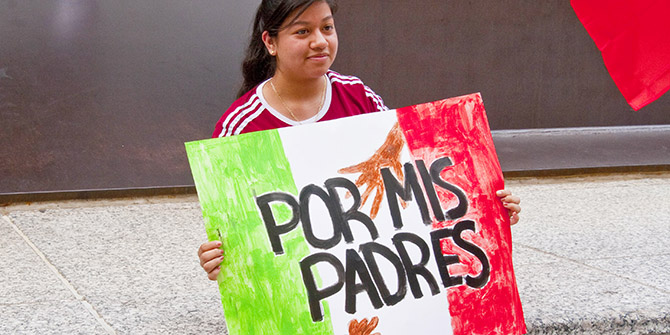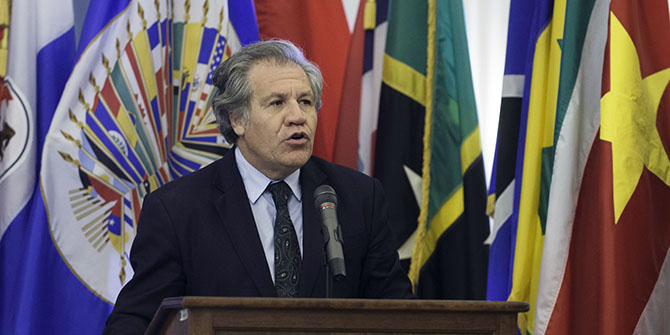 Mexico’s resort to riot police and tear gas is part of a wider effort to scare migrants into returning to Central America. But push factors like extreme violence and grinding poverty weigh far more in the balance than shows of dissuasive violence, writes Alejandra Díaz de Leon (LSE Department of Sociology).
Mexico’s resort to riot police and tear gas is part of a wider effort to scare migrants into returning to Central America. But push factors like extreme violence and grinding poverty weigh far more in the balance than shows of dissuasive violence, writes Alejandra Díaz de Leon (LSE Department of Sociology).
A migrant caravan made up of approximately 2,000 Hondurans (including women, children, and families) is currently making its way towards the United States after entering Mexico through Guatemala. The intention of most of these migrants is to walk across Mexico to the US-Mexico border and apply for asylum in the United States. Since the caravan set off, president Trump has tweeted his opposition and threatened both Honduras and Guatemala with sanctions if they were to allow the caravan to cross their borders.

The Mexican government responded by sending riot police to the border to prevent migrants from crossing. The images of black-clad security forces using their shields against mothers and babies were shocking and disturbing. They also teargassed the group before ultimately allowing them through.
As more and more people joined the caravan, the group moved into Tapachula, a town in the southern state of Chiapas, before travelling north into Oaxaca. It is expected to continue on towards the United States unless Mexico takes drastic steps to stop it.
The role of Mexico in controlling Central American migration
The “clash” between the Mexican government and this caravan of Hondurans fleeing poverty, instability, corruption, and violence illustrates one of the current tensions between undocumented migrants and states worldwide.
On one side we find desperate but determined people willing to keep pushing forward in an attempt to improve their own and their families’ lives. On the other we find governments attempting to dissuade them from moving by intensifying the costs of migrating, usually by making their experience more dangerous and expensive.
The Mexican government used riot police and threats of violence in the hope of frightening migrants into returning to their home country. But the caravan’s desire to press forward shows that this was a miscalculation. Although this represents the state’s most public act of deterrence to date, it is not the first time that Mexico has tried to make the journey north more dangerous for Central American migrants.
On the contrary, Mexico’s southern border has seen a steady increase in checkpoints, detention centres, and guards. At times, Mexico has been responsible for deporting more Central American migrants than the United States.
Dissuasive violence versus overwhelming push factors
However, my conversations with thousands of migrants over the years have taught me that these deterrence strategies never work. Many migrants are aware of the violence in Mexico, and they know that they might be killed, disappeared, robbed, or injured, yet they still choose to leave.

As Jairo, a 20-year-old migrant from Tela in Honduras, told me in southern Mexico in 2016:
In Honduras you have to buy everything: food, protection, healthcare. We were starving there. We were scared. The gangs wouldn’t leave us alone. I didn’t want to come to Mexico. I was pushed.
Blockading roads, building walls, and increasing the number checkpoints only forces migrants to take more secretive and dangerous routes, which in turn increases their likelihood of experiencing violence.
Activists and academics have demonstrated repeatedly that every time Mexico makes migration more difficult, violence against migrants increases. But still Central American migrants continue to flee their hometowns. As another migrant told me:
Of course, we know it is dangerous, but you have to understand us… Take me for example. I knew that if I stayed in San Pedro Sula [in Honduras], I would be killed by the gangs. If I left for the United States, I might make it and survive.
Putting obstacles and dangers in the path of migrants leaving desperate situations doesn’t work; they have nothing to lose and everything to gain.
The caravan as a practical and political reaction to mistreatment in Mexico
The caravan itself is a practical reaction to the way migrants have been treated in Mexico for years. Travelling in a large group with activists and journalists provides support and security. The caravan decreases monetary and physical costs because migrants are less exposed to criminal or official violence. It precludes the need to employ a “coyote”, or people smuggler.
But migrant caravans are also political. Walking over 3,000 km across Mexican territory with only their backpacks, their children, and their chants, members of the caravan remind us that they are human, that they are victims of violence in Mexico, and that they are fleeing violence and poverty at home.
This visibility of the migrant caravan – aided in part by Donald Trump’s tweets and statements – has forced a discussion on how undocumented migrants are treated in Mexico and what role the country should play in future.
A vital first step for both the Mexican government and the Trump administration would be to recognise that dissuasion doesn’t work.
Notes:
• The views expressed here are of the authors and do not reflect the position of the Centre or of the LSE
• Please read our Comments Policy before commenting





